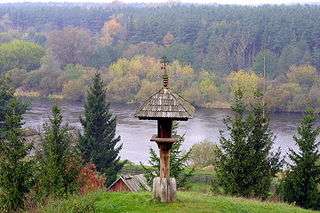Nowogród
| Nowogród | ||
|---|---|---|
|
View on Narew from Kurpie Museum | ||
| ||
 Nowogród | ||
| Coordinates: 53°13′35″N 21°52′46″E / 53.22639°N 21.87944°ECoordinates: 53°13′35″N 21°52′46″E / 53.22639°N 21.87944°E | ||
| Country |
| |
| Voivodeship | Podlaskie | |
| County | Łomża | |
| Gmina | Nowogród | |
| Area | ||
| • Total | 20.55 km2 (7.93 sq mi) | |
| Population (2006) | ||
| • Total | 2,014 | |
| • Density | 98/km2 (250/sq mi) | |
| Postal code | 18-414 | |
| Website | http://www.nowogrod.com | |
Nowogród [nɔˈvɔɡrut] is a small town in northeastern Poland located about 13 kilometres (8 miles) away from the city of Łomża, in Łomża County, in Podlaskie Voivodeship, with 1,998 inhabitants (2004). It is centered on the area known as Skansen Kurpiowski which is an open-air museum, with several examples of mostly 19th century architecture from the region of Kurpie. The museum is dedicated to local Kurpie culture and is a popular folk tourist attraction. It was established by Adam Chętnik in 1927, and now features over 3000 items.
The river Narew flows through the town and has a myriad of views from the hills amongst it. The town's landmark is a World War II tank that stands overlooking the Narew river from atop a hill.
While contemporary Nowogrod lies on a hill along the Narew river, the ancient gord was located at the confluence of the Narew and the Pisa. In late Middle Ages, Nowogrod used to be one of the most important towns of the Duchy of Mazovia. It was the seat of a royal castellany, granted town charter in 1427, to lose it in 1869.
The history of the gord of Nowogrod dates back to the 9th century, as archaeologists found several objects, such as axes and tools, which date back to that period. Some time probably in the 12th century, the gord was moved on the high bank of the Narew, and at that time it was probably named Nowogrod. By early 14th century, it already was the seat of a castellany; on Nowogrod’s stamp from 1320, a Latin inscription Signum Novogrodensis is visible.
Since the area of Nowogrod was located near the border with Lithuania and Yotvingians, it was frequently raided by the warring neighbours. In 1355, the gord became property of Siemowit III, Duke of Masovia, who in 1375 handed it to his son Janusz I of Warsaw. Janusz I founded here a brick castle, built in the location of a wooden construction. The castle became one of residences of the Dukes of Mazovia. Nowogrod received town charter in 1427, and named a royal town, it enjoyed a number of privileges, especially during the period known as Polish Golden Age, when it was an important center of trade, commerce and honey-making. The period of prosperity ended during the Swedish invasion of Poland (1655 - 1660). The town was ransacked and burned to the ground, never recovering from the destruction.
In 1794, during the Kosciuszko Uprising, a battle between Poles and Russians took place near Nowogrod. Also, a skirmish took place here during the November Uprising.
During the German Invasion of Poland, heavy fighting between Poles and the advancing Wehrmacht took place here, leaving Nowogrod almost completely destroyed.
Nowogrod has a Roman Catholic parish church, which dates back to the 15th century. Burned and destroyed several times, the church was renovated in 1980-82. There also is a cemetery of Polish soldiers who fell in the Polish-Soviet war of 1920, and a monument dedicated to them in 1923.
-01.jpg) Kurpie home and windmill at Skansen Kurpiowski
Kurpie home and windmill at Skansen Kurpiowski- Kurpie beehive at Skansen Kurpiowski

